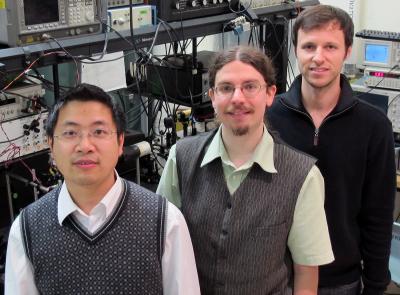Nov 16 2012
Using tiny radiation pressure forces -- generated each time light is reflected off a surface -- University of Oregon physicists converted an optical field, or signal, from one color to another. Aided by a "dark mode," the conversion occurs through the coupling between light and a mechanical oscillator, without interruption by thermal mechanical vibrations.
 Graduate student co-authors, L to R, Chunhua Dong, Victor Fiore and Mark Kuzyk worked with their faculty adviser Hailin Wang, a physicist at the University of Oregon, to employ a theorized "dark mode" to convert an optical field, a signal, from one color to another. Credit: University of Oregon
Graduate student co-authors, L to R, Chunhua Dong, Victor Fiore and Mark Kuzyk worked with their faculty adviser Hailin Wang, a physicist at the University of Oregon, to employ a theorized "dark mode" to convert an optical field, a signal, from one color to another. Credit: University of Oregon
In the quest for networking quantum systems and eventually building a quantum Internet -- where photons carry information -- color conversion will be crucial, said co-author Hailin Wang, a member of the Oregon Center for Optics and a professor in the UO physics department. Getting different quantum systems, or nodes, to talk to each other is a major challenge since these systems communicate with photons of distinct wavelength or color. "This is not unlike getting a PC to talk to a Mac, but it involves a quite different process," he said.
"Optomechanical systems can be used to store light and change its color -- operations that are important for a quantum network," said co-author Chunhua Dong, a postdoctoral research associate in Wang's lab.
In a paper appearing Nov. 16 online via Science Express in advance of publication in the journal Science, the Oregon group describes the discovery. The group's experiment couples the radiation pressure force that is generated by light circulating inside a glass microsphere -- about the size of a human hair -- to the mechanical breathing motion of the microsphere. One can change the color of a light pulse by first exciting a mechanical vibration through the optomechanical coupling, and then using the vibration to generate a new light pulse at the desired color.
Making the conversion currently is limited by thermal mechanical motion -- only at temperatures approaching absolute zero can such an approach be useful for quantum applications. As an example of the challenge, the researchers said, consider a tuning fork:
"If you were able to look at the tuning fork very closely, you would see that it is always vibrating a little bit on its own, just from the thermal motion," said co-author Victor Fiore, a graduate student. "This causes a problem because the noise from the thermal motion can swamp out the signal that we care about."
The Oregon group solved the problem by demonstrating the "dark-mode" approach proposed earlier this year by theoretical physicists from McGill University and the University of California, Merced. By achieving the dark mode, the color-conversion process is immune to thermal noise, even though the conversion is still mediated by the same mechanical oscillator. This approach provides an alternative to cooling the mechanical oscillator to eliminate the noise.
Describing the dark mode is difficult, but co-author Mark C. Kuzyk, another graduate student in Wang's lab, suggests picturing three children sitting on swings, holding hands. "The two outermost kids are the photons (light) of different colors, and the middle child is the mechanical oscillator. When all three children are sitting still, there are no photons or vibrations in the system. If we push one of the swings, all three kids will start moving. In the dark mode approach, we push and pull on the swings in a special way that generates a very particular pattern of swinging.
"As the child on the left hand side moves forward," Kuzyk continued, "the child on the right hand side moves backward, such that the middle child never moves. This is interesting because even though the middle child never moves, she is a necessary part of the system. Without her, there would be no way to couple the two outermost swings."
For applications in a quantum Internet, the next challenge is to demonstrate that this process can work at the level of a single photon and can be implemented on a semiconductor chip, Wang said.
"This fundamental research in the Oregon Center for Optics is vitally important for the development of advanced computing systems for the future," said Kimberly Andrews Espy, UO vice president for research and innovation, and dean of the graduate school. "This work in Dr. Wang's lab is on the cutting edge of research in physics to harness new ways to harness and manipulate photons in efficient and economical ways."